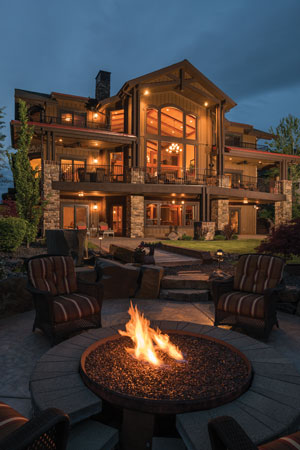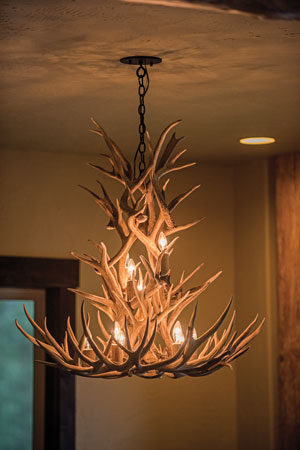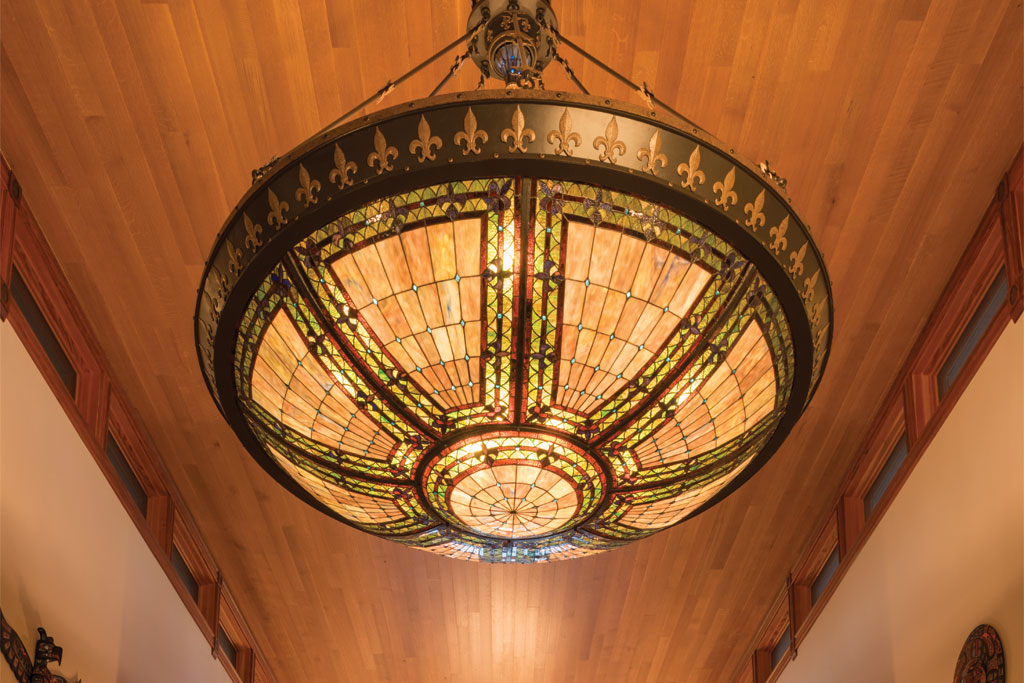Lighting is often overlooked, yet it is one of the most powerful elements in home design. Alone it can create a vibe, evoke feelings, even enhance your appearance — or detract from it. You might say you know good lighting when you feel it. But the actual fixtures themselves can be just as interesting as the glow they cast. Glass pendant lanterns, stained-glass chandeliers, handcrafted antler masterpieces. Lighting is art. It is function. It is essential. And it can make or break a room. We asked the experts how they use lighting to accentuate a home. Their approach is, as you might expect, illuminating.
>> Go for the gusto ~ Don’t just fill space. Make a statement.
When you walk into this Hayden Lake home, you step into a grand entryway with an 18-foot ceiling made of quarter-sawn white oak.
The challenge for lighting consultant Dianne Ansbaugh was to illuminate this vast space without disturbing the beautiful straight-grain pattern woodwork.
“I couldn’t bear the thought of cutting holes to place recessed cans,” she said.
So she didn’t. Working with the homeowner, she found a way to preserve the wood, add volume to the space and provide enough ambient lighting without the glare of exposed light bulbs.
The solution: a 186-pound Meyda Tiffany stained-glass chandelier that hangs prominently in the entryway. Dianne mirrored the look on the opposite end of the main floor with a second chandelier above the dining table.
Getting the lighting just right was an effort. Dianne and the homeowner, who is an architect, mocked up what they wanted, got on ladders to make sure the dimensions were exact for the space and then commissioned the 6-foot 6-inch diameter chandeliers. It took about 10 months to build the lights.
“The homeowner wanted quality without compromise,” Dianne says. “He also wanted something unique that would complement the many antiques and unusual Northwest Coast art throughout the home. The challenge came in sizing the fixtures.”
Dianne admits it was tricky but worth the effort.
“Lighting is the jewelry of the home. It’s an extension of the owner’s personality,” she says. “Subtle or dramatic, it’s like art. You will know it fits you when you see it.”
>> Go with the flow
Use lighting to define and transition
Walls, colors and furniture are common ways to define space in a home. But an overlooked yet equally effective way is to use lighting, interior designer Lynn Fleming says.
Lynn incorporated about 30 different light fixtures, both LED tape and art lighting as well as chandeliers and sconces, to define space in her client’s 4,800-square-foot home on the Spokane River. She had to seamlessly link a grand entryway, wide hallways and large open living spaces on each of the two floors. She chose timeless, simple and classic fixtures, complementing her client’s bright Northwest coast palette and character.
“The workhorse of good lighting is what you do not see. The art lights, LED tape under cabinets, wall washers outside, under-cabinet LEDs,” she says, emphasizing that decorative lighting is a supporting role to the functional design. “Light is a paint brush and decorative fixtures are the final flourish.”
Lynn worked closely with her client to pick the more ornamental lighting. They started with the kitchen, choosing two glass lanterns to fill the space over the kitchen island. Lynn balanced the look in the dining space with an understated single shade chandelier and two matching wall sconces. The complementary fixtures give separation between the two adjacent spaces but also keep them congruent.
“I will pick lighting any day over any other material,” Lynn says. “Without light, both the inanimate and animate appear less vibrant.”

Interior Designer: Lynn Fleming
>> Exterior effect
In many ways, lighting the exterior of your home is just as important as the interior. For Pat and Jan Long’s 6,651-square-foot home on the Spokane River, the challenge was three-fold: Ensuring the home is lit for safety, keeping the light from polluting the night sky, and setting it apart from neighboring homes. This is what successful outdoor lighting looks like.
>> Mix it up
Pair rustic antler lighting with contemporary, even eclectic decor.
Jim Swanson makes antler lighting. Chandeliers, lamps and wall sconces. He’s done so for more than 20 years, so you can imagine he’s pretty good at it. In fact, he’s so good his lights illuminate homes around the world.
Jim owns Antler Chandeliers & Lighting in Polson, Mont. An artist and tradesman, he crafts his pieces in a shop filled with car-sized piles of deer, elk and moose antlers. It’s where Steve Rice met him to commission the antler chandelier that hangs above the dining table he had made in India.
You wouldn’t think the two styles work together. They do. In fact many of Jim’s clients incorporate their antler lighting with all kinds of decorative styles. His biggest market is New York City, where he mainly sells high-gloss white-painted chandeliers to apartment and condo owners. He describes two kinds of clients: the kind who likes antlers and the kind who instead of seeing antlers sees curves and nuances of the shapes.
“They’re looking at more of the beauty of it,” Jim says.

Light Designer: Jim Swanson
Jim is more focused on the craftsmanship of his lights; he leaves the interior design to his customers. It’s that craftsmanship — the authenticity, artistry and attention to detail — that sets him apart and draws clients from all over.
Using real antlers, Jim carefully wires each fixture, hiding the wires inside the antlers for a clean, authentic look. He spends the most time arranging the antlers so the piece fits together well and is proportionate. Once he builds the fixture, he then takes it apart to drill holes and install the wiring. Then he rebuilds it. After that comes the detailing process, filling in the holes to match the bumpy texture of the antler and painting the piece to replenish the color that the human eye sees when looking at antlers.
Jim has crafted antler chandeliers for European castles and for the rich and famous. He counts fashion designer Ralph Lauren as a client.
The designer asked Jim to make him rustic, bleached-out and weathered chandeliers.
“I didn’t build them rustic enough for him,”Jim says with a laugh. “He said ‘no, rustic, rustic, rustic.’” So Jim went back and roughened them up some more. The designer ended up pairing his rustic chandeliers with dark Queen Ann-style furniture.
“I thought, ‘This can’t look right,’” Jim says. “It’s stunning what people can do.”
By Kristina Lyman
Photography By Joel Riner
As Featured In: Summer/Fall 2017





1 Comment
Thanks for the interesting read about lighting design. I’m glad that you talked about mixing it up by using the example of antler lighting. The chandelier you showed has such an interesting an unique shape to it that it’s almost mesmerizing. I’m curious to see what other unique light fixtures people have made, especially if it fits into the overall design of their home.